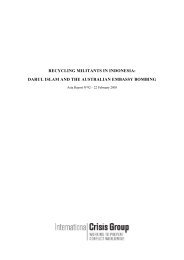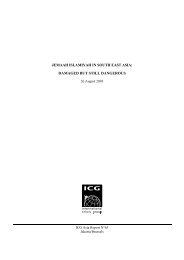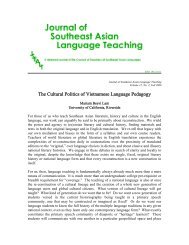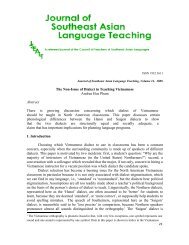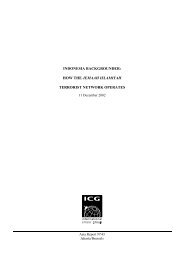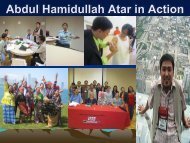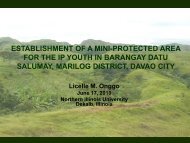Introduction - SEAsite - Northern Illinois University
Introduction - SEAsite - Northern Illinois University
Introduction - SEAsite - Northern Illinois University
Create successful ePaper yourself
Turn your PDF publications into a flip-book with our unique Google optimized e-Paper software.
Prentation Abstracts<br />
system in need of change. Students can and should be given the opportunity to<br />
explore education development in conversations with others who shape policy. If<br />
education in Laos would become a primary priority, socioeconomic development<br />
would greatly benefit and, moreover, would be strengthened by the possibility that<br />
the dreams of students could become a reality.<br />
Susan Meredith Burt<br />
How to Get Rid of an Unwanted Suitor: Advice from<br />
Hmong Elders<br />
Department of English, <strong>Illinois</strong> State <strong>University</strong>, Normal, <strong>Illinois</strong><br />
In an interview designed to assess changes in the pragmatics of the Hmong<br />
spoken by the immigrant generation and college-age young adults in a Hmong immigrant<br />
community in Wisconsin, interviewees were presented with the following<br />
prompt:<br />
“A young woman is at the Hmong New Year Festival. A young man wants to<br />
play the ball toss game [a traditional courting game] with her, but she does not<br />
want to. What are some ways she can ask him to leave her alone? Which way<br />
seems best to you? Do young women today know how to say this?”<br />
When we analyze immigrant women’s responses to this face-threatening<br />
scenario by generation, striking differences emerge: the elders recommend using<br />
bald-on-record statements and blunt, unmitigated directives; the one exception<br />
to this is the youngest elder, who uses an excuse and a postponement. Younger<br />
women, who have grown up in the U.S., overwhelmingly recommend using excuses<br />
and postponements, the occasional apology, and no directives. The younger<br />
speakers, to western ears, sound far less direct and more polite than the female<br />
elders recommend—a pattern that seems puzzling.<br />
The explanation lies in the different cultural conditions under which the<br />
speakers imagine the interaction taking place, as these were immensely different<br />
for women who grew up in Laos than for those who grew up in the U.S. In Laos,<br />
a suitor posed a real threat to a woman’s autonomy; Hmong marriage customs<br />
included possible marriage by capture, bride-price negotiations, and marriage possibly<br />
resulting in lower status as a second wife in a polygamous household. Thus,<br />
the interaction involved higher stakes for the older women, when they were young,<br />
than it does today for young women growing up in the US.<br />
One cultural discontinuity that marks the Hmong refugee immigration from<br />
Laos to the United States is a change in the relative status of women within Hmong<br />
society (Donnelly 1994, Meredith and Rowe 1986). What the data on this speech<br />
act type show is that that change in status affects the politeness strategies speakers<br />
bring to interaction, although not, perhaps, in quite the way that Brown and Levinson<br />
(1987) would predict. Here, the increased power that a relatively higher status<br />
brings to women in the US allows them to prioritize goals of self-presentation over<br />
goals of self-preservation, in that a suitor in the US does not usually constitute the<br />
dire threat to the woman’s autonomy that he could in Laos; from her relatively safe<br />
position, then the woman can afford to be less direct, more polite in her attempt to<br />
discourage an unwanted suitor.<br />
Somsonge Burusphat, Ph.D.<br />
Lao numeral classifiers in comparison to Central Thai<br />
Institute of Language and Culture for Rural Development, Mahidol <strong>University</strong>,<br />
Salaya, Nakhonpathom, Thailand<br />
This paper presents a semantic analysis of numeral classifier system in the<br />
Lao language. The hierarchically structured set of parameters underlying categorizations<br />
of nouns presented in a tree diagram has been applied to this study.<br />
Shape/form component has the largest number of classes. The classes that<br />
have a lot of members are duàaN, nuÜay, saàay, seÝn, baày, phµàµn, phQÜn,<br />
huàa, and meßt. Most of these classes involve metaphorical extension into another<br />
semantic field. Repeaters are mostly used with entities possessing the nature/function<br />
component. The general classifier /an can be used with entities of any size and<br />
can replace some inanimate classifiers. The arrangement component mostly consists<br />
of classifiers which are derived verbs. The human classifier khoân is widely<br />
used whereas phuÝu is restricted to the indefinite construction: noun- phuÝunumeral<br />
one. The use of non-human classifier toào has been extended from its<br />
original realm to class bad humans and inanimate objects. The animate collection<br />
component distinguishes between human and non-human. Thus a group of people<br />
belongs to one class and a group of animal belongs to another. The inanimate<br />
collection component overlaps with the arrangement component. A collection of<br />
inanimate objects are classified according to how they are arranged, e.g., a pile,<br />
a bundle, and a bunch. Partitive component partially relates to arrangement, e.g,<br />
a lump of object is in tÜn class and a slice of object is in piÜaN class. This<br />
component also distinguishes between ‘one of a pair’ of body parts and inanimate<br />
objects. That is one hand is in the bµßaN or khaÝaN class and one shoe or sock is<br />
in the kiÜN class which is the same class as ‘twig’.<br />
The comparative study of Lao and Thai numeral systems reveals that there<br />
is a great similarity of traditional use of numeral classifiers in both languages. The<br />
difference lies on the innovative classification of entities.<br />
Kristine Callis<br />
Historical Plant Use in Laos from Accounts of European<br />
Exploration<br />
Department of Botany, North Carolina State <strong>University</strong>, North Carolina<br />
The study of European texts on Laos, from the 16th-19th centuries, offers<br />
an examination of the evolution of both Lao and European culture. Investigating<br />
the plant use described by Europeans reveals a possible shift in traditional environmental<br />
knowledge (TEK) by the native Lao. Many of the plants described in<br />
the texts were used medicinally and some have been examined for modern pharmaceutical<br />
use. These pharmaceutical studies have substantiated the effectiveness<br />
of historical medicinal plant use. The texts also describe plants that were used in<br />
religious ceremonies and continue to play an important role in Lao culture. Understanding<br />
the plants that are important to the native Lao in the past can lead to better<br />
methods of conservation in the future.<br />
Jacquelyn Chagnon<br />
Reaching the Poorest in the Lao DPR Requires<br />
Cutting Edge Approaches<br />
Rural Development Consultant, Participatory Development Associates, Lao PDR<br />
In the mid-1990’s, the Lao government consciously began to shift its rural<br />
development focus towards the least advantaged, least accessible, and most wartraumatized<br />
districts of the country. In 2003 the Lao PDR’s Report on the National<br />
Poverty Eradication Program identified through quantitative and qualitative measures<br />
72 poor districts out of 142. Top priority was given to 40 districts. Almost all<br />
were in remote upland areas characterized by high ethnic diversity, low education<br />
rates, and inadequate outreach of government services. Decidedly, these districts<br />
presented the zenith of development challenges.<br />
Drawing from her decades of professional development experience, the<br />
writer raises three critical challenges for reaching remote poor districts. First, how<br />
can the critical core of indigenous development professionals emerge in these districts,<br />
where education levels average 2-3 grades? Second, as many of the poorest<br />
districts are plagued by high levels of unexploded ordnance (UXO), can clearing<br />
methods be improved to meet popular demands? Third, with an underpaid, understaffed<br />
civil service core, what alternatives are there for providing basic health and<br />
education services in these remote, low population areas? For each challenge, the<br />
writer highlights some cutting edge approaches being tested in the Lao PDR.<br />
Phinseng Channgakham*<br />
Rural Financial Development: Farm Credit Access and Credit<br />
Constrains of Rural Farm Households in Naxaithong and<br />
Phonghon Districts in Lao PDR<br />
* Ph.D. Student (Lao)<br />
International Graduate School of Social and Sciences, Yokohama National<br />
<strong>University</strong>, Japan<br />
Access to rural financial services has a crucial role to play on poverty reduction<br />
in rural areas. Farm credit is needed for short-term investment as well as<br />
medium- and long-term investment, especially credit for purchasing inputs and<br />
investing in livestock and tree crops. This study attempts to search on main determinants<br />
which influence on farm household borrowing behavior and their credit<br />
constrain. The survey was conducted in Phonghon district of Vientiane Province<br />
and Naxaithong district of Vientiane Municipality where villages are classified as<br />
rural zones with the road access. Both loan borrowing and non-borrowing farm






